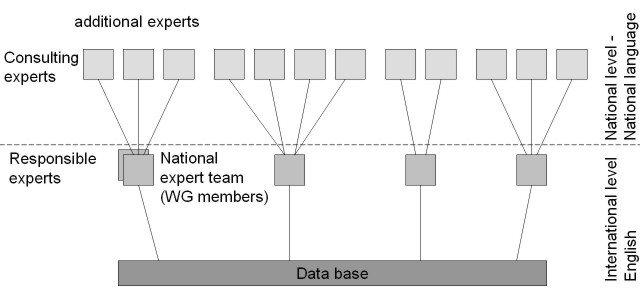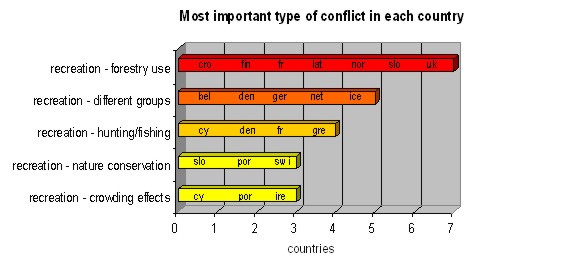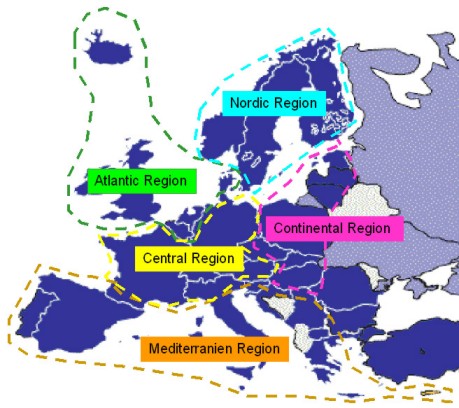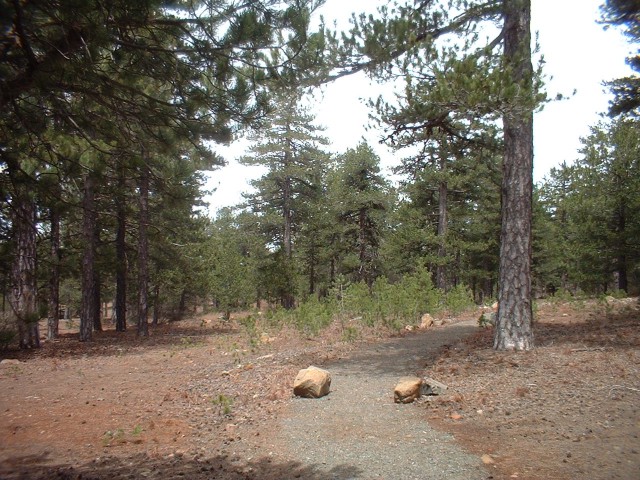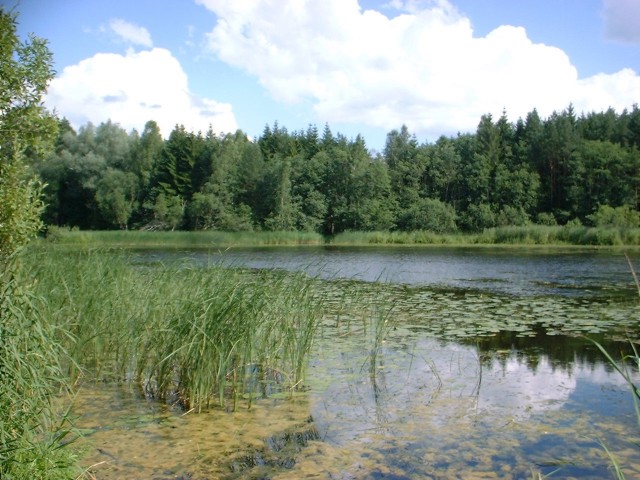4 Conflicts arising from outdoor recreation and nature tourism and sustainable management of resources and environments
The previous section examined the general issues of nature tourism and some of the conflicts that arise, mainly between over development and damage to the resources from too many visitors. This section considers the conflicts involved in the management of natural areas, especially forests, across different parts of the world. Here there are not only conflicts between recreational or tourism visitors and the natural resource but also among and between recreational activities. This presents many challenges to managers. However, not all conflicts occur everywhere and there are distinct regional patterns that emerge from an analysis of different countries. The first part looks at the situation in Europe which is best known to the authors from work on Cost Action E33. This is followed by summaries of the situation from other regions.
4.1 Europe
The following review is based on the analysis of a survey which was undertaken for the Cost Action E33 programme mentioned above. It was the first attempt to produce a picture of the situation across the whole of Europe and it reflects the situation of the present time. Survey questions were designed to reflect expert knowledge, in relation to forest functions, forest management, and forest based recreation management. One survey form was sent to a representative of each country, who was asked to complete the survey in collaboration with other national experts knowledgeable in the respective fields (see Figure 10*). This type of questioning prevented one single expert from responding solely on the basis of personal observations and opinions.
The results include the answers from forest practitioners and researchers working within the respective regional or national forestry administrations of each country (Pröbstl, 2005; Pröbstl et al., 2007*). The survey was addressed to the national representative member of the Cost Action programme, who was invited to be responsible for the questionnaires in his or her country based mainly on personal invitations leading to a high response rate (over 80%).
In the following, some results of this survey (Pröbstl et al., 2007) concerning conflicts in recreation management are presented. The first approach showed a rather diverse picture which showed some basic trends. However, a more differentiated analysis and discussion with the experts was able to identify significant regional variations (see Figure 11*).
Figure 11* summarizes the most important types of conflicts across Europe. It can be seen that in countries which are characterized only by a small amount of forest (for example the U.K.) and those with an intensive and very productive forestry (such as Finland and Norway) most of the conflicts occur between “recreation and forest use”, mainly timber harvest activities where health and safety considerations as well as difficulties in using harvested areas for recreation were cited as reasons. In densely populated countries the conflicts between different user groups tended to dominate (for example Belgium, Denmark and Germany). This is because there are often many user groups competing for space. In the Mediterranean countries and France hunting is considered as the most severe problem causing conflicts with recreation.
However, analysis of the pattern of conflicts arising from outdoor recreation and nature tourism and the sustainable management of resources and environments revealed significant regional differences. Overall, five regional groups of countries emerged which are characterised by similar foci, conflicts and management tasks (Figure 12*):
- The Atlantic region
- The Central European region
- The Mediterranean region
- The Nordic region
- The Continental region
Below, the main concerns and challenges for each region are described. The relative priority of these topics is influenced significantly by the overall amount of forest, the population density, the legal situation, and, especially, access.
The Atlantic Region is characterised by a very low proportion of forest cover per country, usually in the region of 5–11%. In Iceland, Ireland, Denmark, the U.K. and the Benelux countries, the provision of recreation opportunities is of utmost importance as forests represent one of the main types of accessible land use for recreational purposes. The high population density and relatively low proportion of forest (< 11%) leads to an emphasis on recreation as a major policy objective for forest management and a subject of a focus both in research and practice. The main challenges for management are the aesthetic enhancement of plantation forests for the purpose of recreation and the development of urban forestry (among others, Heytze and Herbert, 1990; McCormack and O’Leary, 1995; Bell, 1997). Compared to other regions, the main conflicts are crowding and the recreational demands of different ethnic groups. In the Benelux countries and in the U.K. the combination of intensive recreation and nature conservation also poses a special challenge (Bruls et al., 2004; Roovers et al., 2004). Additional challenges for management are on the one hand the supply of recreation opportunities and conflict resolution between different user groups, crowding, and rubbish dumping. On the other hand the increasing demand for an open access to forests is of increasing relevance for recreation and tourism. Surveys and monitoring of visitor numbers, changing demands and efforts to ensure that there are accessible forest areas close to where people live are an integral aspect of forest management.
In the Nordic Region challenges are completely different. These countries contain an extremely high proportion of forest (up to 69%). In Sweden, Norway, and Finland, multi-functional forestry must include the traditional “every man’s rights” which include berry picking, mushroom collecting, and free access for all recreation and sports activities, which are considered of utmost importance by the entire population (Sievänen et al., 2004). The main conflicts are between forestry and recreation. Large clearcuts and road contruction are mentioned as major problems by many researchers and managers from these countries. Compared with these issues, the severity and frequency of other conflicts is considered to be rather low. Forest managers have to deal with an increasing number of conflicts with the use of snow mobiles in winter, unauthorised motorized camping and erosion caused by mountain biking. The management concepts differ across the various Nordic countries. While management in Finland is mainly based on a standardized method for visitor surveys there is no tradition in Norway for systematic collection of data and users of nature, except for national surveys organized by Statistics Norway. By contrast monitoring in Norway is primarily biological monitoring. Management has to deal with the precondition of free access. Therefore restrictive management actions such as limiting the number of visitors able to visit an area, or the use of entrance fees to ration visitor numbers are unlikely to be feasible, while softer actions such as visitor information, signposting and guided tours are more acceptable (Vistad, 2003). In the Nordic region increasing ecotourism is a new challenge for forest mangement.
In the countries of Central Europe, such as Germany, Switzerland, and Austria, as well as large areas of France, typically about one third of the area is under forest cover and all countries provide free access to the forest. Conflicts arise mainly between different user groups (for example between horse riders and cyclists, or cyclists and hikers) and between recreation demands and nature conservation priorities. Conflicts exist in areas with greater restrictions from nature conservation and they predominantly involve outdoor sports. These conflicts also occur in forests close to urban areas. In the mountain areas, off-piste skiing, back country skiing and snow shoeing as well as montain biking lead to conflicts. The planning of new recreational infrastructure has a long tradition in Central Europe. Visitor management is a constant challenge for managers, especially in and close to densely populated areas. Management and monitoring of recreation mainly occurs as an integrated task of forest inventory or management planning. Only in special cases is there independent planning for recreation and nature tourism. New forms of conflict resolution have been developed using contracts and voluntary agreements with sport associations, especially concerning rock climbing and cross-county skiing.
The Continental Region (i.e. Poland, the Baltic states, the Czech Republic, Slovakia and others) face a different set of challenges, partly as a result of the legacy of the Soviet or communist era, restitution of forest lands to their former owners and rural depopulation. Recreation has always been an important management concern, but frequently appropriate infrastructure, or controlled access may be absent. Many prerequisites for more intensive tourism use are also missing. The restructuring of agriculture, and the widespread conversion of arable land to shrubs and eventually to forests is leading to significant changes in the rural landscape. The main conflict area is between recreation and nature conservation. Most of the protected areas have been established in Eastern Europe during the last 20 or 30 years, many of them in traditional recreational locations, for example in Latvia and along the Baltic coast line and in mountainous areas. The mountainous areas of the Czech Republic, Slovakia and southern Poland are facing increasing problems, especially with ski touring, cross country skiing, snow shoeing and snow mobiles as well as climbing and mountain biking. The planning, management and monitoring systems are similar to those used in the Central region. They are mainly connected with forest inventory and management or with the management plans for protected areas. Around bigger cities and urban areas, the recreational planning as well as the management of the recreational infrastructure is more intensive. The most popular management actions used in these countries are restrictive ones, particularly rules and regulations, but also prohibitions, although their acceptance by the public appears to be rather low. Experts in the region also mentioned the education of future management personnel as a challenge, especially with regard to training in the areas of recreation and or eco-tourism. New challenges derive from the forest ownership transformation process in these countries.
The Mediterranean Region also contains about one third of its area as forest, but here it is different type of forest, often being sparse in terms of tree cover and composed of trees suited to the climate but which are also flammable. Timber production is not important so one of the main additional uses in forests is tourism, which requires landscapes of high aesthetic quality, and also leads to further demands such as fire management, the provision of recreational infrastructure, and the restoration of previously intensively used areas. Rubbish dumping by private individuals was mentioned by the experts as a “tradition” in almost all Mediterranean countries causing a lot of problems for forest management. Some areas are currently subject to intensive reforestation, or at least to the stabilization of marginal forests in semi-arid areas. All these activities also need to consider demands for nature conservation.
In most of the mediterranean countries there is no independent planning or monitoring of recreation and nature tourism in forests. In Greece and Italy, for example, recreational planning is mainly done in special cases, especially around larger cities to provide recreational opportunities. In Cyprus a close cooperation between the Cyprus Tourism Organization, the Forestry department and other stakeholders has fostered strategic planning and monitoring of forests, rural tourism and nature tourism projects. Future challenges were mainly seen in an increasing need for environmental education, new demands like “nature tourism” and the necessity for visitor monitoring.
4.2 North America
In the U.S.A., with a tradition of strong private property rights and no public access to private land, the main resources for outdoor recreation have, for a long time, been the public lands managed by the National Park Service, the U.S. Forest Service, the Bureau of Land Management (BLM) and the network of state parks managed by each state. Significant infrastructure development was put in place several decades ago and the period of the 1980s saw reductions in federal funding to these agencies. In the U.S.A., the population is set to increase as a result of immigration and the ethnic mix of the population is also expected to change so that patterns of leisure and recreation are likely to be different. Health concerns such as the “epidemic of obesity” and the need to increase the physical activity levels of the American population are also at the forefront of policies connected with outdoor recreation (Cordell, 2005). Meanwhile, the pressures placed on well-loved and accessible national parks such as Yosemite lead to severe conflicts of visitor numbers, activities and the protection and management of natural resources. There have traditionally been differences between the different management agencies, the National Park Service being concerned with scenery, nature and recreation management and therefore a more focused remit than the Forest Service or BLM which each have goals to develop and use a wide range of natural resources. This, such as timber cutting in old-growth forests of the Pacific North-west has led to conflicts over resource use and nature conservation, scenic preservation and recreation. Tools to manage visitors and visitor pressure have featured in the management systems of the agencies for some time and these continue to be developed and applied. One of the strong points of these approaches such as the Recreation Opportunity Spectrum is to connect the nature of the visitor experience with the type of landscape setting within which this experience takes place. Another tool, Limits of Acceptable Change is used to manage the changes to the ecology that occur as a result of high levels of visitor use (Haider, 2004). In addition, given the popularity of motorised vehicles in the U.S.A., conflicts between these and the natural resources are a constant theme requiring management action and monitoring.
The U.S. Forest Service has a research programme that undertakes research in to provide information about recreation use of forests, supply and demand of recreation opportunities, and impacts of resource management activities and landscape change on recreation activities (USDA, 2006). A broad range of topics are studied including:
- Relationships between ecological conditions and recreation activities: impacts of fire on recreation activities.
- Cultural differences in outdoor recreation use: minority ethnic group participation in outdoor recreation; access to leisure and urban open space opportunities.
- Psychological and social dimensions of the recreation experience: human values and perceptions associated with recreation activities; sense of place and recreation management; experiential aspects of wilderness; impacts of criminal activity in forests on recreation; use of recreation fees; recreation visitor conflicts.
- Recreation assessment and trends: visitor service quality assessment; national recreation assessment and trend analysis (NSRE); national visitor use monitoring (NVUM); scenic quality assessment.
Many of these activities are reflected in the aspects described in earlier sections and demonstrate that many of the concerns are common to a wide range of areas around the world.
4.3 Principles of sustainable nature tourism
Given the kinds of possible conflicts described above it is important to be able to develop sustainable methods for managing recreation and tourism. Metsähallitus, the state Forest and Park Service in Finland, is responsible for managing most of the country’s protected areas as well as supplying partly the country’s forest industry. The organisation has developed nine principles which summarise the key elements of managing sustainable nature tourism in protected areas (Metsähallitus, 2000):
- Natural values should be preserved and all activities should promote nature conservation. Features are small groups; erosion and impacts monitored; nature is the prime reason for the visit; marked trails; tourism into area with suitable features; nature education and awareness are central.
- The environment must be subjected to as little pressure as possible. Every effort is taken to avoid damage and disturbance; no trace of visitors should be left behind; emissions minimised and renewable energy sources preferred.
- Local traditions, cultures and communities must be respected. Visitors are encouraged to learn about the communities and cultures in the area; local communities are considered in the provision of information and activities; guides familiar with local conditions.
- Visitors should increase their understanding and appreciation of nature and cultures. Information should be available prior to the visit; information available on arrival, guides well trained; information and interpretation easily accessible and attractive; visitors are able to contribute to the management of the area.
- Improved recreational facilities must be provided for visitors. Needs of visitors considered; facilities to suit demand and conditions; visitors to enjoy peace and quiet as well as guided activities; facilities and services developed in cooperation with local businesses.
- Visitors should be encouraged to enjoy both mental and physical recreation. Facilities provided for range of visitors. i.e. hikers and bikers as well as casual recreational walkers; easy and demanding routes available; opportunities for a variety of activities in natural surroundings.
- Local economies and employment must be promoted. Local businesses to be used wherever possible; employment given to local people wherever possible.
- Publicity materials should be produced responsibly and carefully. Information must be reliable and up-to-date; publicity is conducted openly and interactively and does not work against nature conservation.
- Activities must be planned and organised co-operatively. Visitor’s opinions are important; training organised with local businesses; all stakeholders involved in planning.
In developing a nature tourism operation, it is essential to clearly identify the destination and to have a unique selling point. The natural assets of a destination play an increasingly important part in presenting and marketing a tourism experience (Buckley, 2001*). If an area is listed as a World Heritage Site, for example, this indicates globally outstanding natural and/or cultural significance. This can potentially cause conflicts where an increased number of visitors cause intense pressure on the infrastructure and support services within the area. Eagles et al. (2000) estimated that in 1996, there were more than 2.6 billion visitor days of recreation activity in the parks and protected areas of Canada and the U.S.A. This level of activity is likely to have major economic, social and environmental impacts.
It is essential to develop partnerships between tourism, environmental and community interests. These partnerships all need to have a shared understanding of the processes and benefits but also of the commitments entailed. A large number of Codes of Conduct for tourism have been developed by a range of organizations regarding environmental, socio-cultural and political features and behaviour. Many of these are pertinent to nature tourism: the World Tourism Organisation of the UN Global Code of Ethics for Tourism (World Tourism Organization, 2001); the United Nations Environment Programme Principles on the Implementation of Sustainable Tourism (UNEP, 2000); the World Wildlife Fund (WWF) Ten Principles for Mediterranean Tourism; the Pacific Asia Travel Association (PATA) Code for Environmentally Responsible Tourism; the WWF Guidelines for Community-Based Ecotourism Development (WWF, 2001), and the Environmental Guidelines of the World Travel and Tourism Council (WTTC, 1998). These codes are designed to ensure that all the actors involved understand what is trying to be achieved but also that everyone is working towards the same process and goal. Within the codes, issues such as waste disposal, disturbance to wildlife and habitats, respecting cultures, supporting education and complying with the country’s safety standards, are covered.
To be successful and to retain the support of the local community, any nature tourism operations have to provide economic benefits. It is important that these benefits are shared with the community and not all taken out of the area. Parks often supply the most important part of the nature tourism experience, but typically capture little of the value of the stream of economic benefits (Wells, 1997*).
Nature tourism depends on a high quality environment to attract visitors. As a result, the negative effects of tourism need to be minimised. This will also help to reduce conflict with local communities. Moreover, nature tourism should contribute actively to the conservation of natural and cultural heritage. If the area is allowed to degrade, either through lack of management or through over-exploitation, then the area will lose its attractiveness to visitors (Newsome et al., 2002). The direct impacts of tourists, such as trampling and litter, have been fairly extensively studied. However, impacts which are more diffuse, indirect and intermittent which are difficult and expensive to measure such as waterborne pathogens or interference with plant pollination ecology are less well-understood (Buckley, 2001*). To reduce conflicts and tensions between local populations and tourists, it is imperative that these effects are also considered and researched.
To be sustainable, it is important that any nature tourism development encourages community involvement and participation. Local and indigenous communities should be included in planning, development and operation (Denman, 2002*). Local people should be involved from the outset, at the planning stage right through to gaining the economic benefits of the operation as a result of employment generated by the project or by being key stakeholders. However, one of the problems of local community participation is that it can be difficult for it to be equal. Some people choose not to participate (Ghimire and Pimbert, 1997*) or it may not be possible for some to participate so that they benefit economically. One of the key problems is that tourism may not actually link well enough to local communities dependent on natural resources and traditional rural livelihoods. Ghimire and Pimbert (1997) have presented a six-part typology of participation ranging from passive participation where people are told what will happen with no input to decisions to interactive participation where people are involved in joint analysis where new local groups are formed or strengthened and they take control over local decisions and practices (this parcipation ladder is quite frequent in participatory planning research).
All stakeholders should be encouraged to engage in the planning process and in liaison between tourism enterprises, government bodies and environmental planners. Participatory management is a key tool in ensuring participation in planning, decision-making and management (Denman, 2002). One important task is to develop tools and approaches to improve integrating local knowledge into decision making and planning processes. In developing countries especially, it is important to encourage management styles based upon local rules and collective action. This should ensure long-term preservation of national resources as well as a sustained supply of resources required by nature tourists.
4.4 Management of nature tourism
A number of indicators have been developed to enable tourism stakeholders and nature tourism operators to assess the sustainability of their activities. These cover issues such as the well-being of host communities, tourist satisfaction and management of scarce resources. For example, the World Tourism Organisation produced a book entitled Indicators of Sustainable Development for Tourism Destinations in 2004 (World Tourism Organization, 2004*), the Department for Culture, Media and Sport (DCMS) produced National Sustainable Tourism Indicators in 2001 (DCMS, 2001) and the Association of Caribbean States (ACS) have developed a set of indicators that are quantifiable and applicable through a Tourism Sustainability Index in order to create a Sustainable Tourism Zone for the Caribbean (Simpson and Ladle, 2007). When developing new areas for Nature Tourism, it is important to consider the carrying capacity of the area, not only in terms of the local community but also for the visitors. Natural areas are often diverse landscapes with a number of features attractive to different groups of people for different reasons. However, diversity often leads to conflict, where visitors who are seeking different experiences find themselves in the same setting. In the future conflicts will increase between clients seeking for peace and quietness in the wilderness and clients interested in motorised outdoor activities.
Eagles (2001) suggests that the negative impact of tourism on park resources is less influenced by absolute numbers of visitors, and more influenced by weak tourism policy, management and staffing often caused by very low levels of finance. Managers of protected areas worldwide face the challenge of conserving natural and cultural heritage for future generations, ensuring that conservation values are not degraded by the current generation’s use and appreciation of these areas (Buckley, 2001). There is a danger that, by identifying and promoting prominent natural areas for tourism, the numbers visiting and their associated impacts can actually degrade what most people value in the area. Visitor use can negatively affect the environment as well as the quality of visitor experiences. In order to improve any services offered, ensure all stakeholders are satisfied and the integrity of the environment is maintained, it is essential that strategies and impacts are monitored, evaluated and reviewed (World Tourism Organization, 2004). It is also important to undertake market research on the visitors to assess their satisfaction with the area and facilities. This will enable the development of pragmatic and effective recommendations for addressing any existing and future problems.

